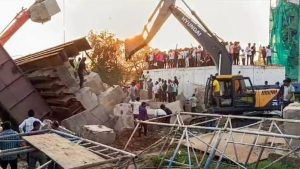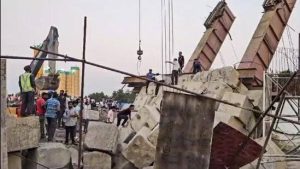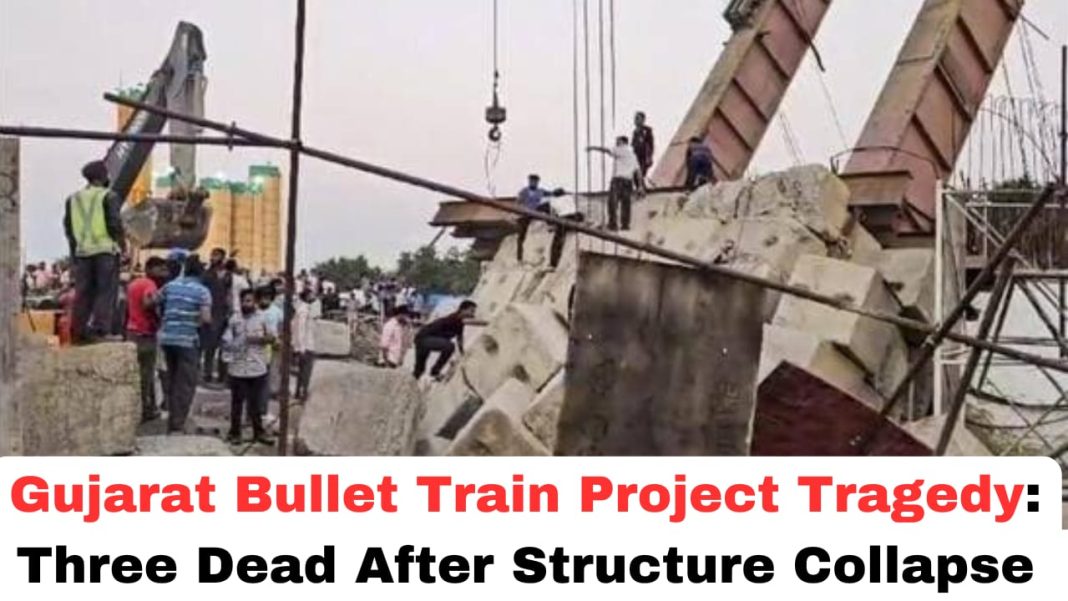Digital News Desk:
Details of the Incident
A tragic accident occurred on November 5, 2024, at the Mumbai-Ahmedabad bullet train project site near Vasad in Gujarat, resulting in the deaths of three workers after a structure collapsed. This temporary structure, part of the foundation work, unexpectedly failed when concrete blocks weighing over two tons fell, trapping the workers. Local authorities and rescue teams quickly responded, saving one additional worker who remains hospitalized.
The National High-Speed Rail Corporation Limited (NHSRCL), which oversees this ambitious infrastructure project, expressed condolences and announced a compensation of Rs 20 lakh for each affected family. They have launched an investigation to determine the structural issues behind the collapse. The incident has drawn attention to safety measures within large construction projects in India, highlighting the need for stringent regulations to safeguard workers in high-risk environments.
Background of the Bullet Train Project
India’s bullet train project, connecting Mumbai and Ahmedabad, is a landmark initiative in partnership with Japan, inspired by the Shinkansen. Managed by the National High-Speed Rail Corporation Limited (NHSRCL), the project is poised to reduce travel time between the two cities from over seven hours to just two. However, the project has encountered delays, challenges in land acquisition, and now a serious safety incident.

The accident in Gujarat raises important questions about the safety measures implemented in large-scale construction projects. Structural collapses on such projects are rare but significant, given the scale of materials and manpower involved. For the families affected, this incident has brought unimaginable grief, highlighting the critical need for stronger safety standards in infrastructure projects across India.
Safety Concerns and Regulatory Gaps
This incident has reignited concerns about workplace safety in India, particularly in the construction sector. Major infrastructure projects like the bullet train corridor are often fast-tracked, and the pressure to complete these projects can sometimes lead to safety compromises. India has a robust framework for safety regulations in place, including guidelines for construction site management. However, experts have often pointed out that these regulations are inconsistently enforced, especially in large projects involving multiple contractors and subcontractors.
The tragedy in Gujarat has prompted renewed calls for safety audits, and there are demands for an independent inquiry to determine the root cause of the collapse. The National High-Speed Rail Corporation has assured the public that a full investigation will be carried out. Public safety advocates argue that large-scale projects should include rigorous third-party inspections to ensure that safety protocols are strictly followed. This particular incident could prompt a reevaluation of safety protocols across the sector.
Worker Conditions and Rights in India’s Construction Industry
The accident also casts a spotlight on the conditions and rights of construction workers in India. Many of the workers involved in this project, like those in other construction projects, are migrants from economically disadvantaged regions, often earning daily wages and working under demanding conditions. Despite their critical role, these workers frequently lack adequate protection, including health insurance, compensation guarantees, and support for their families in case of accidents.

For the families of the deceased and injured workers, the collapse represents not just a tragic loss but also a potential financial crisis. The construction industry, though vital to India’s development, has long been criticized for insufficient attention to worker welfare. Labor organizations have been vocal in urging the government and the NHSRCL to provide financial compensation and support to the families affected by this tragedy. This incident could lead to further discussions on how to improve safety and support mechanisms for workers involved in risky construction work.
Broader Implications for India’s Infrastructure Goals
India’s infrastructure projects, from highways to rail networks, are key components of the country’s economic development strategy. However, these projects often come with significant human and environmental costs. This recent accident underscores a critical point in India’s rapid infrastructure expansion: the importance of prioritizing safety as much as innovation. Balancing development with responsibility remains a challenge as India aims to modernize its infrastructure and make it competitive on a global scale.
Incidents like the bullet train accident remind us that infrastructure is more than just concrete, steel, and economic projections—it involves the lives and well-being of people who work on and eventually use these projects. As India pushes forward with ambitious projects, ensuring safe working conditions and implementing strict safety standards is essential to minimize risk to both workers and future passengers.
Impact on the Workforce and Their Families
The lives lost and injuries sustained represent a stark reminder of the risks construction workers face in large-scale infrastructure projects. The bullet train project, while hailed as a transformative initiative for India’s future, has placed immense demands on its workforce, who often operate under difficult conditions to meet tight deadlines. For the families of the deceased and injured workers, the accident is a tragic turn of events, adding immense grief to an already precarious livelihood. Many of the workers on this project, as with most construction sites in India, come from economically disadvantaged backgrounds and travel far from their hometowns for these job opportunities. For them and their families, the consequences of such accidents are often devastating, leading to financial instability and emotional trauma.

Looking Ahead: Balancing Progress with Safety
The Gujarat accident is a sobering reminder of the risks associated with large-scale infrastructure development. For a project as ambitious as the Mumbai-Ahmedabad bullet train, which aims to propel India into the ranks of countries with high-speed rail systems, the importance of ensuring the safety of all stakeholders cannot be overstated. Modern infrastructure is crucial to economic development, but its benefits should not come at the cost of human life.
In light of this accident, safety advocates are urging the NHSRCL and other bodies overseeing major projects to strengthen oversight, implement more frequent safety inspections, and provide greater support for workers. There is also a call for incorporating lessons from international high-speed rail projects, where safety standards have often been rigorously enforced.
Ultimately, the tragic loss of life in Gujarat could act as a catalyst for lasting changes in how India approaches construction safety. Ensuring that projects are completed without endangering workers is crucial, and the nation has a moral obligation to prevent similar incidents in the future.
You May Also Read: Sharda Sinha Passes Away: The Folk Music Icon Who Defined Chhath Puja for Generations








